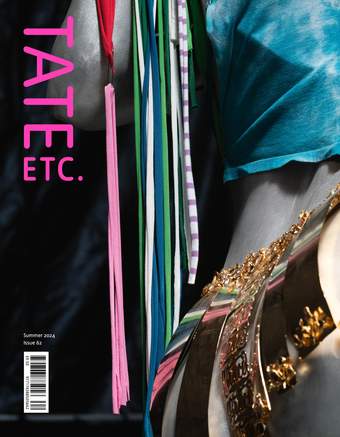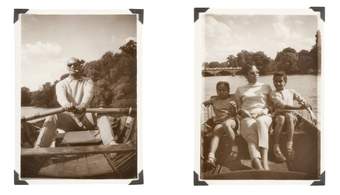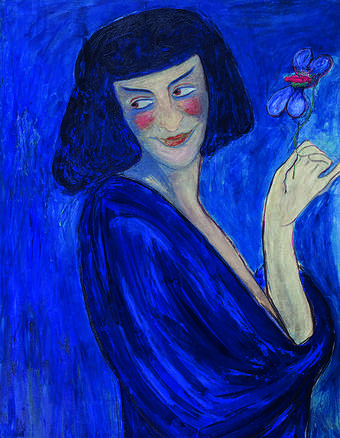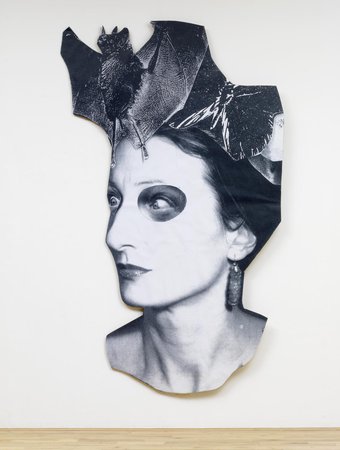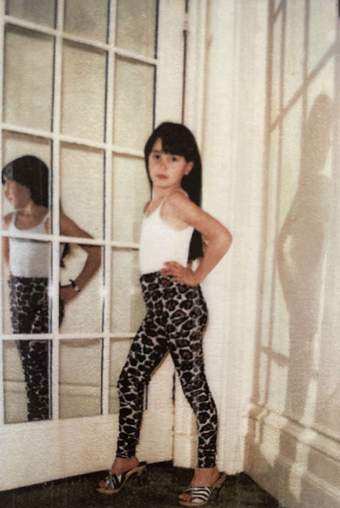
Monster Chetwynd, aged seven, striking a pose inspired by the work of Helmut Newton
© Monster Chetwynd
During my childhood we were always on the move. Before my family of nine finally settled in London, we had lived in Australia and Malaysia and Hong Kong and Pakistan – hotels, a local Cantonese school, the house of a Zoroastrian family. When we lived in Sydney, we would visit the people who made the Rocky Horror Picture Show. I remember a room with old TVs all piled on top of each other, playing black and white cartoons. My earliest memories are of these places, as well as the photography books we kept at home. I was very keen on Helmut Newton.
I started going to see indie bands when I was 13, moving up to raves when I was 16. I used to go to an amazing area above King’s Cross station, where there were elaborate and exuberant warehouse parties. The person who organised them wandered around dressed as Napoleon, and in the middle of one giant room were double beds with naked obese women lounging about on them, doing nothing for hours on end. Around that time, I also used to watch The Young Ones on TV. In that programme there are edits between the story of the friends in the flat, the story of the rotting food in their fridge and the story of some abstract other space that is a parallel existence. I would wonder why anyone would bother to live in any other way if this was possible.
I started to throw parties in the rented flats I lived in as a way to make what I wanted to happen exist. The parties included sketches or performances and fancy dress – and they were fun. I did not understand that they qualified as art for a long time. To feel high without being intoxicated, to make an event, mixing people and props and costumes and ideas. What does that reveal, I wonder?
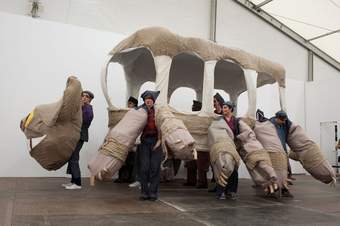
A performance of Chetwynd’s A Tax Haven Run By Women at Frieze Art Fair, 2010
© Monster Chetwynd. Courtesy the artist and Sadie Coles HQ, London. Photo: Marie Luisa
You can become an artist without knowing you are, by researching or developing unconventional ways to be creative. It’s not easy to pinpoint what made me want to be an artist. Salvador Dalí’s jewellery, Alexander Calder’s Circus, Cocteau – or Dekalog, Mae West, Marx Brothers? Also reading transformative and life-changing books, by Bakhtin or Bulgakov. On the one hand I have some unstoppable energy that wants to allow warmth and human bonding, libertine behaviour, humour and un-stuffiness. The other part of me is drawn to the desire to learn. To discuss and share ideas and to be conscious and agile and awake. Maybe they fit together; I know that I have always wanted to be an audience as well as a maker.
People often ask me where I get my ideas from. I can give an example. Recently, I had to take one of my cats to an emergency vet to be operated on. The vet himself was distractingly handsome. After two days of worrying about the cat’s progress, the handsome vet announced that he was well enough to be released. I duly arrived to collect him but realised I had forgotten my wallet. The cat was congratulated: it was on the mend. I apologised and promised to return.
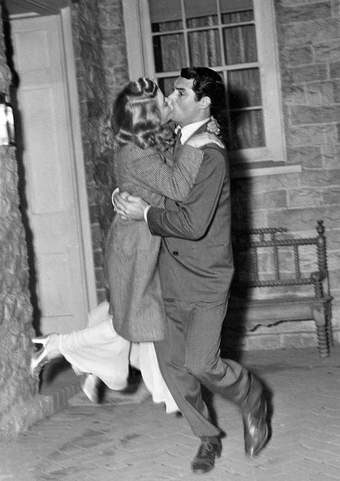
Cary Grant and Priscilla Lane in Arsenic and Old Lace (1944)
Back home, I cooked a quick dinner for my mum and shoved on a film, not really caring what it was. It looked odd – almost bad. It was a Cary Grant film called Arsenic and Old Lace (1944). When I returned, having paid the vet, the film had taken a dark turn: Grant sat with heavy ropes around his neck and body, and the ‘baddies’ were about to cut up his face and torture him. I asked Nonna if she was OK with the film. She was gripped and failed to answer. I sat down next to her and tried to follow the rest of the film. It had a complicated plot that climaxes with Cary Grant behaving in a euphoric way. He locks his newly wedded wife in a snog that involves a slapstick walk during which they manage to move around kissing, looking like a strange new creature.
When the film ended, Nonna turned to me and said: ‘You know what we should do? We should have an Arsenic and Old Lace party!’ She was right; we should. We have all the characters, and the correct-shaped house with an internal staircase, a basement and a small garden. So many good aspects of the dark jokes are parallel to our lives. We started laughing; it was such a good idea. Earlier that evening I had been thinking how perpetual and dull my life was, how I meet a handsome vet and fail to tell him he is hot. Then, within an hour, I am given a flash of inspiration that will drive me to throw a party. I will work towards all the props and references becoming reality, and all the guests understanding those references enough for them to enjoy it. I am back on track, not bothered about the grind of life, happy knowing that I am going to make this creativity follow through.
Monster Chetwynd’s A Tax Haven Run By Women 2010–11 was purchased in 2017 and is included in the free collection display Performer and Participant at Tate Modern.
Monster Chetwynd is an artist who lives and works in Zürich.

